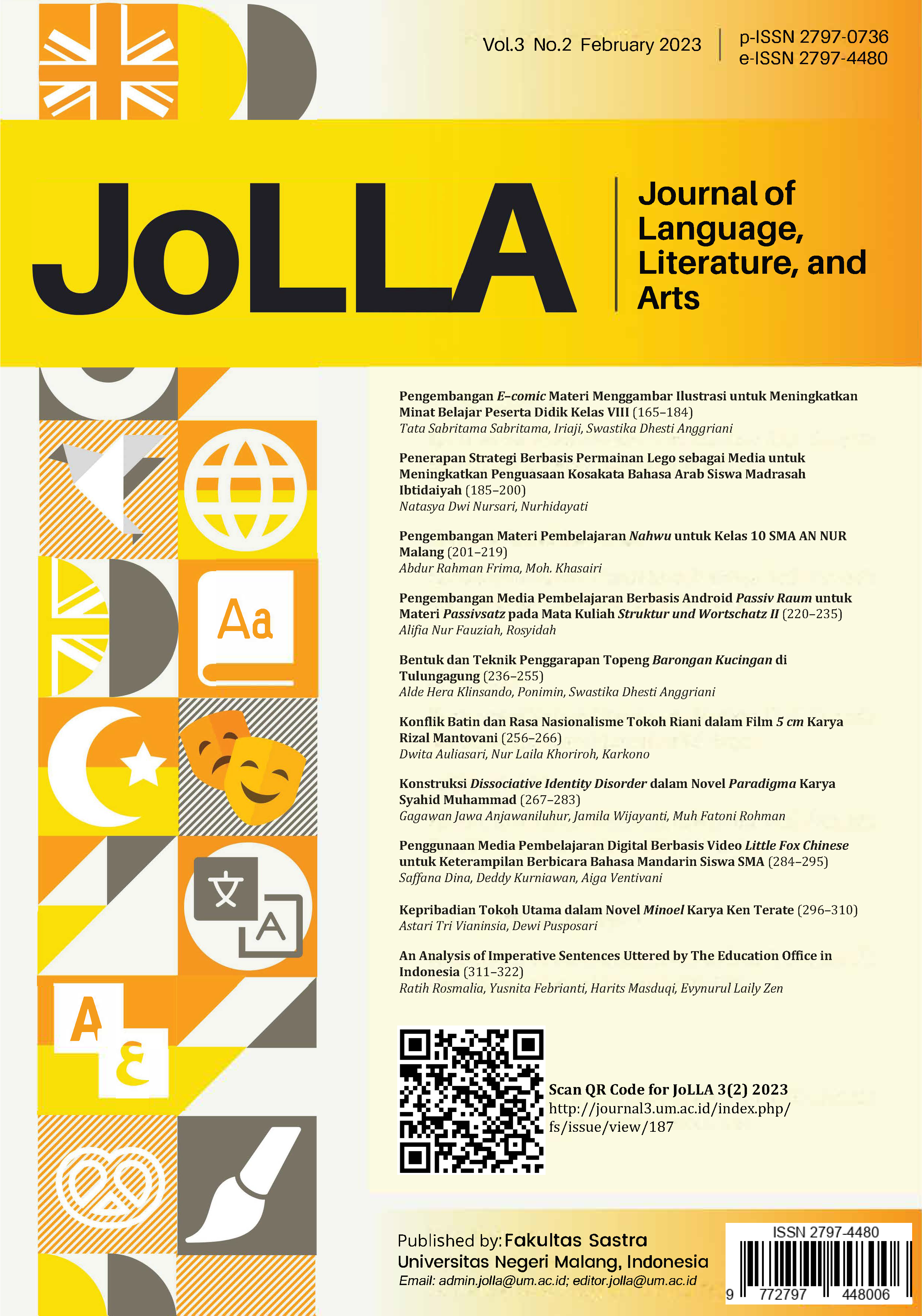Konstruksi Dissociative Identity Disorder dalam Novel Paradigma Karya Syahid Muhammad
DOI:
https://doi.org/10.17977/um064v3i22023p267-283Keywords:
Konstruksi, Dissociative Identity Disorder, Novel ParadigmaAbstract
Dissociative Identity Disorder atau DID adalah sebuah gangguan pada mental seseorang yang merujuk pada kondisi memiliki lebih dari satu kepribadian dalam satu tubuh. Selain dapat ditemukan dalam dunia nyata, DID juga kerap kali muncul sebagai ide penciptaan karya sastra. Penelitian ini mengkaji terkait DID yang tersirat dalam novel Paradigma karya Syahid Muhammad. Penelitian ini difokuskan kepada dua tokoh yang memiliki indikasi DID yaitu, Rana dan Ikrar. Untuk memperoleh temuan yang diharapkan, peneliti menggunakan penelitian deskriptif kualitatif dengan desain studi teks. Data berupa kalimat kutipan novel Paradigma karya Syahid Muhammad yang berbentuk narasi, dialog, dan monolog tokoh terkait DID. Peneliti menggunakan teknik pengumpulan data baca dan catat. Data yang telah terkumpul selanjutnya dianalisis menggunakan teknik reduksi data, penyajian data, dan penarikan kesimpulan. Hasil dari penelitian ini berupa gejala DID, seperti adanya dua identitas yang bergantian mengendalikan tubuh, ketidakmampuan mengingat informasi personal, tidak disebabkan oleh obat terlarang dan minuman keras, dan masing-masing identitas memiliki citra diri, sejarah, dan nama. Selanjutnya, ditemukan penyebab kemunculan DID dalam diri tokoh Rana dan Ikrar, yaitu trauma, kesusahan berat, usaha meredam keinginan, dan dorongan keinginan untuk dapat berdiri sendiri. Kemudian, ditemukan juga sikap orang sekitar terhadap penderita berupa prasangka buruk dan diskriminasi.
Kata kunci: konstruksi; dissociative identity disorder; gangguan mental; novel Paradigma
Construction of Dissociative Identity Disorder in the Novel Paradigma by Syahid Muhammad
Dissociative Identity Disorder or DID is a mental disorder that refers to the condition of having more than one personality in one body. Besides being found in the real world, DID also often appears as an idea for creating literary works. This research examines DID that is implied in Syahid Muhammad's Novel Paradigma. This research is focused on two figures who have DID indications, namely, Rana and Ikrar. To obtain the data, researchers used a qualitative descriptive study with a text study design. The data is in the form of excerpts from the novel Paradigma in the form of narratives, dialogues, and monologues related to DID. Researchers used reading and note-taking data collection techniques. The data that has been collected then analyzed using data reduction techniques, data presentation, and drawing conclusions. The results of this study are in the form of DID symptoms such as the existence of two identities that take turns controlling the body, the inability to remember personal information, are not caused by drugs and alcohol, and each identity has a self-image, history, and name. Furthermore, it was found that the causes of the emergence of DID in the characters Rana and Ikrar, namely trauma, severe distress, efforts to suppress desires, and encouragement to be able to stand alone. Then, it was also found that the attitude of people around the sufferer was in the form of prejudice and discrimination.
Kata kunci: construction; dissociative identity disorder; mental disorder; novel Paradigma
References
Armsden, G. C., McCauley, E., Greenberg, M. T., Burke, P. M., & Mitchell, J. R. (1990). Parent and Peer Attachment in Early Edolescent Depression. Journal of Abnormal Child Psychology, 18(6), 683-697.
Atkinson, R. L., Atkinson, R. C., E, S. E., & Bem, D. J. (2000). Pengantar Psikologi. Edisi Kesebelas. Batam: Penerbit Interaksara.
Baron, R.A., & Byrne, D. (2005). Psikologi sosial (10th ed). Jakarta. Erlangga.
Brown, J.D. (1998). The Self. Massachussetts: Mc.Graw Hill Inc.
Budiman, D. (2007). Bahan Ajar MK Psikologi Anak dalam Penjas PGSD. Bandung: UPI.
Cramer, P. (2015). Understanding Defense Mechanisms. Psychodynamic Psychiatry, 43(4), 523.
Davison, Gerald C., dkk. (2006). Psikologi Abnormal. Jakarta: PT. Rajagrafindo Persada.
Dayakisni, T. & Hudaniah. (2015). Psikologi Sosial. (Edisi Revisi). Malang. UMM Press.
Dharma, Agus. (2002), Manajemen Perilaku Organisasi: Pendayagunaan Sumber Daya Manusia. Jakarta: Erlangga.
Durand, V.M., Barlow, D.H. (2006). Intisari Psikologi Abnormal. Edisi IV. Yogyakarta: Pustaka Pelajar.
Eliasa, E. I. (2011). Pentingnya Kelekatan Orangtua dalam Internal Working Model untuk Pembentukan Karakter Anak (Kajian Berdasarkan Teori Kelekatan dari John Bowlby). Dalam Karakter Sebagai Saripati Tumbuh Kembang Anak Usia Dini. Yogyakarta: Inti Media Yogyakarta Bekerjasama dengan Pusat Studi Pendidikan Anak Usia Dini Lembaga Penelitian Universitas Negeri Yogyakarta.
Freud, A. (1937). The Ego and the mechanisms of defense. London: Hogarth Press and Institute of Psycho-Analysis
Ghea, A. A. (2013). Psychological Disorder Perilaku Abnormal: Mitos dan kenyataan. Humaniora, 4(1), 692-704.
Gullone, E., & Robinson, K. (2005). The Inventory of Parent and Peer Attachment-Revised (IPPA‐R) for Children: a Psychometric Investigation. Clinical Psychology & Psychotherapy: An International Journal of Theory & Practice, 12(1), 67-79.
Halgin, R. P. & Whitbourne, S. K. (2010). Psikologi Abnormal Perspektif Klinis pada Gangguan Psikologis Edisi 6 Buku 1. Jakarta: Salemba Humanika.
Hambali, A., & Jaenudin, U. (2013). Psikologi Kepribadian Lanjutan: Studi atas Teori dan Tokoh Psikologi Kepribadian. Bandung: CV Pustaka Setia.
Hatfield, E. & Rapson, R. L. 2010. Culture, Attachment Style, and Romantic Relationships. Bulletin of Social Psychology: Unknow Publishing
International Society for the Study of Trauma and Dissociation. (2011). Guidelines for Treating Dissociative Identity Disorder in Adults, Third Revision: Summary Version. Journal of Trauma & Dissociation, 12(2), 188-212. DOI: 10.1080/15299732.2011.537248
Kartono, Kartini. 1981. Patologi Sosial jilid 1. Bandung: Rajawali Press
Maslim, Rusdi. (2013). Diagnosis Gangguan Jiwa, Rujukan Ringkas PPDGJ-III dan DSM-5. Jakarta: PT Nuh Jaya.
Matlin, M. (1999). Psychology. 3rd Edition. Orlando: Harcourt Brace College Publishers.
Miles, M.B, Huberman, A.M, & Saldana, J. (2014). Qualitative Data Analysis, A Methods Sourcebook, Edition 3. USA: Sage Publications. Terjemahan Tjetjep Rohindi Rohidi, UI-Press.
Muhammad, Syahid. (2018). Paradigma. Yogyakarta: Gradien Mediatama.
Mustikasari, D. (2018). Perilaku Gangguan Identitas Disosiatif (GID) Tokoh Fleur Radella dalam Novel Les Masques Karya Indah Hanaco: Sebuah Pendekatan Struktural dan Psikoanalisis. Skripsi. Yogyakarta: Rogram Studi Sastra Indonesia Fakultas Sastra Universitas Sanata Dharma.
Overvad, A. T., & Wagoner, B. (2020). Grief after Suicide: A Study of Taboo and Metaphor. Culture & Psychology, 26(3), 369-383.
Prigerson, H. G., Boelen, P. A., Xu, J., Smith, K. V., & Maciejewski, P. K. (2021). Validation of the New DSM‐5‐TR Criteria for Prolonged Grief Disorder and the PG‐13‐Revised (PG‐13‐R) Scale. World Psychiatry, 20(1), 96-106.
Rahardjo, M. (2018). Studi Teks dalam Penelitian Kualitatif. Disampaikan pada Mata Kuliah Metodologi Penelitian, Sekolah Pascasarjana Universitas Islam Negeri Maulana Malik Ibrahim Malang.
Santrock, J. W. 2003. Adolescence: Perkembangan Remaja (6th ed). Jakarta: Erlangga.
Santrock, J.W. (2007). Remaja Edisi 11 Jilid 2. Jakarta: Erlangga
Shear, M. K. (2012). Grieving and Mourning Gone Awry: Pathway and Course of Complicated Grief. Dialogues in Clinical Neurocience, 14, 119 128. https://doi.org/10.31887/DCNS.2012.14.2/mshear
Spiegel, D., & Rosenfeld, A. A. (1984). Spontaneous Hypnotic Age Regression: case report. The Journal of clinical psychiatry.
Tajfel, H. (1982). Social Identity and Intergroup Relations. Cambridge, England: Cambridge University Press.
Upton, P. (2012). Psikologi Perkembangan. Jakarta: Erlangga
Widyawati. (2021, Oktober 7). Kemenkes Beberkan Masalah Permasalahan Kesehatan Jiwa di Indonesia. Sehatlah Negeriku Sehatlah Bangsaku. Retrieved from https://sehatnegeriku.kemkes.go.id/baca/rilis-media/20211007/1338675/kemenkes-beberkan-masalah-permasalahan-kesehatan-jiwa-di-indonesia/
Worchel, S dkk. (2000). Social Psychology. USA: Wadsworth Thomson Learning.
Zanarini, M. C., Weingeroff, J. L., & Frankenburg, F. R. (2009). Defense Mechanisms Associated with Borderline Personality Disorder. Journal of personality disorders, 23(2), 113
Kartono, Kartini. 1981. Patologi Sosial jilid 1. Bandung: Rajawali Press
Downloads
Published
How to Cite
Issue
Section
License
Copyright (c) 2023 Gagawan Jawa Anjawaniluhur, Jamila Wijayanti, Muh Fatoni Rohman

This work is licensed under a Creative Commons Attribution-ShareAlike 4.0 International License.





























